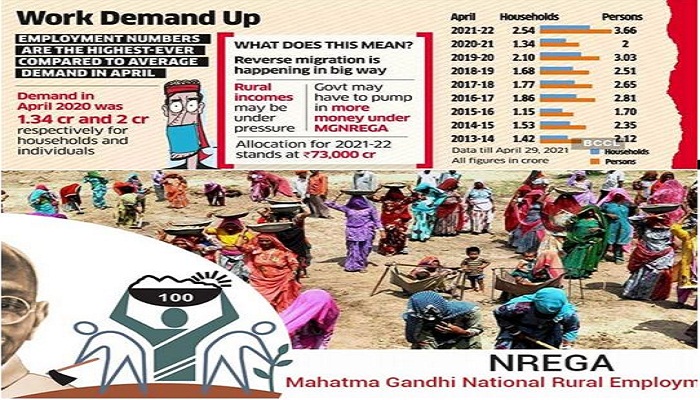Once, Modi had called MGNREGS a living monument of UPA’s failures. It looks like that comment on MGNREGS is going to haunt him, apart from the current debacles of second wave of Covid19 and the Oxygen crisis. The MGNREGS has appeared as a saviour in the crisis period of Covid19.
Under the flagship job scheme MGNREGS, (Mahatma Gandhi National Rural Employment Guarantee Scheme) the Union government has been able to allocate far more work for this April and May than what it did in the corresponding period last year. This indicates that more people might demand job in this second wave of Covid pandemic than during the national lockdown of last year.
In April 2021, the rural development ministry budgeted for 335.7 million person-days or days of work. As India’s Covid19 cases rose, the allocation jumped up to 799.4 million days of work, a rise of around 140%.
Signalling a steep growth in demand, this year, MGNREGS generated 325.2 million days of work in April and it has already passed 335.9 million days in the current month.
In April last year, when India went through an unplanned and worse executed lockdown, to curb the first wave of Covid-19 disease, 175.7 million days of work was allocated. In the next month, work allocation saw a steep hike to 676.3 million days. For the first time in the history of MGNREGS, every month of FY20-21 barring April had more work done than what was budgeted for, as millions of daily wage earners and workers returned home. In the last year, MGNREGS had its highest ever spending of ₹1.11 lakh crores.
This year, due to hubris full of self praise, the authorities had not expected such a massive second wave of Covid-19 and thought normalcy would return. They hoped that workers will return to better work opportunities. A careless attitude in allowing the congregations at Kumbh mela, keeping in mind the upcoming election in UP, added to the Covid19 quagmire. As a result, the second wave has caught the authorities completely off the guard. But now, MGNREGS is gearing up to tackle any possible hike in demand for work, as several states, including Delhi, UP and Maharashtra, are again restoring lockdowns and workers are returning home.
Also Read: Issues faced by India in dealing with Covid 19 resurge- Is it too late to contain the Second Wave
In Union Budget 2021, the centre has allocated ₹73,000 crore for MGNREGS. But, an official said that more demand for work in the programme, widely seen as the last resort of employment in a calamity, would entail more allocations through additional funds or diverting funds from other schemes of the ministry.
The second wave’s penetration in the rural areas has added fresh concerns for managers and officials in MGNREGS. As per a senior official of the rural development ministry, apart from many MGNREGS beneficiaries, many grass-root level officials, who are playing crucial role of maintaining records and ensuring smooth payment systems, might get affected.
The impacts of MGNREGS can also be seen at state levels; for example in Karnataka. Following heavy criticism over stopping of works under the MGNREGA scheme, the State government of Karnataka has allowed such works in rural areas with Covid-19 appropriate behaviour to a maximum of 40 workers at any location.
To allow works under the Mahatma Gandhi National Rural Employment Guarantee (MGNREGA) with certain restrictions, Karnataka government has revised its lockdown orders. The order issued by N Manjunath Prasad, Member Secretary, State Executive Committee of the Disaster Management Authority stated, “Works under MGNREGA are allowed, subject to the condition that not more than 40 workers will be deployed at any location and following Covid Appropriate Behaviour.”
As per State Bank of India (SBI) research, in the month of April, the demand for MGNREGA work by the month’s end had increased to 2.57 crore households, which was 92% higher than a year ago, and a record high for April since 2013.
SBI group chief economic adviser Soumya Kanti Ghosh had said, “This indicates the extent of reverse migration from the lockdown States to their native States.”
The budgetary allocation for MGNREGA (at ₹73,000 crore) was nearly 34.5% lower than last year’s revised estimates of ₹1.11 lakh crore, on the assumption that the economic recovery would alleviate the need for such spending.
For the MGNREGA-scheme in FY 2020-21, the original budgeted spending was around ₹60,000 crore but was enhanced over the year as the national lockdown and large-scale reverse migration from urban employment centres to the hinterland triggered a greater demand of works under the scheme.
Research carried out by Centre for Monitoring of the India Economy on the labour dynamics and the impact of the MGNREGA-scheme has led experts to suggest that GOI should make a larger allocation for MGNREGA-scheme. Additionally, on a sideline with MGNREGA-scheme, other schemes like Jan-Dhan and PDS can be used to ease out the immediate troubles arising out of Covid19-induced restrictions.





